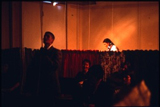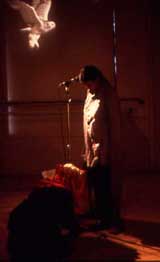Realms of Habitation
| Essay will be published July 2006 by The Center For Art Tapes in Halifax, as part of a retrospective DVD on the work of Rita McKeough
As part of Rita McKeough’s performance work Shudder, presented at Ace Art in Winnipeg in 1998, two speakers mounted on opposite walls traveled rapidly back-and-forth along horizontal tracks while broadcasting an audio recording. The recording is one of few remaining artifacts of the larger work. It consists of a haunting wash of voice and ambient sounds overlaid with a succession of environmental noises – thunder, a ticking clock, an unanswered telephone, sirens, the uncomfortably-close passing of a long freight train, a door, a crying baby. The far-to-near sequence in which these sounds occur, and their gradual crescendo, produce a slowly building anxiety in the listener, a growing sense of things not being quite right, “until,” in McKeough’s words, “it’s right up next to you.” (18/May/2006) The way in which everyday irritants and errors can accumulate until things go undeniably awry is a theme that crops up throughout McKeough’s work. But the sequence of sounds in the Shudder audio track also corresponds to a theme even more fundamental to her wide-ranging body of work, that of the spectrum of our realms of habitation, both symbolic and real. We are all residents of multiple territories. Our bodies (and the consciousness to which they are integral) are our most elemental homes, but we also dwell within the structures formed by our relationships with each other. We create architecture both to house these things and also to draw boundaries around them, and in turn, this architecture pools and scatters throughout the landscape according to further social relationships. We find time oppressive and inescapable and consider ourselves external to nature, even though both time and nature are concepts of our own making. These concentric spheres of “relationships-to” define our place in the world and our experience of it. McKeough’s work hinges on her keen observations of the illusions, injustices and poignancies built into these relationships. Using objects, architecture, sound and action she designs immersive experiences which bring to light contradictions and tensions in our various habitats, physical and otherwise. |
  |
